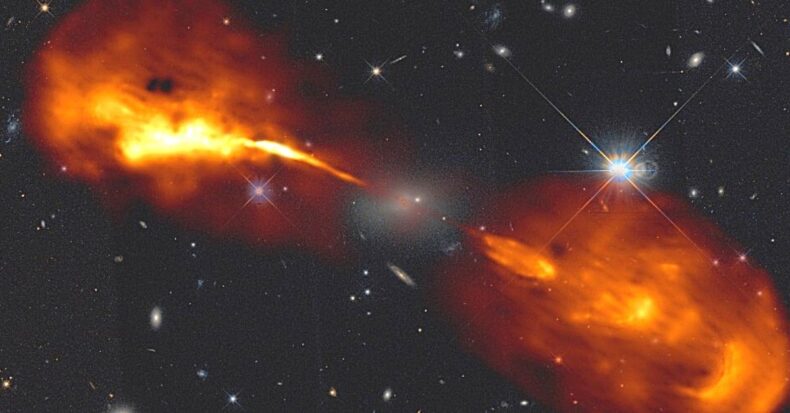An international team of astronomers has published the most detailed photographs ever seen of galaxies beyond our own, revealing their inner workings in unprecedented detail after nearly a decade of investigation.
Data from the Low-Frequency Array (LOFAR), a network of over 70,000 tiny antennae scattered over nine European countries, was used to make the images.
The results come from the team’s years of work, led by Dr. Leah Morabito at Durham University.
The Science and Technology Facilities Council in the United Kingdom helped the team Science and Technology Facilities Council(STFC).
Revealing a hidden universe of light
Electromagnetic radiation abounds throughout the universe, of which visible light is only a tiny part.
Each section of the light spectrum exposes something unique about the universe, from short-wavelength gamma rays and X-rays to long-wavelength microwave and radio waves.
Astronomers have captured images of the heart of galaxies using radio waves.
The LOFAR network captures images at FM radio frequencies that are not blocked by clouds of dust and gas that can cover astronomical objects.
This allows astronomers to peer into star-forming regions or the hearts of galaxies.
The new images, made possible by the collaboration’s global nature, stretch the limits of what we know about galaxies and supermassive black holes.
Eleven research papers explaining these photographs and the scientific results have been published in a special issue of the scientific journal “Astronomy and Astrophysics.”
Better resolution by working together
The images reveal the inner workings of nearby and distant galaxies at a resolution 20 times sharper than typical LOFAR images.
This was made possible by the unique way the team made use of the array.
The 70,000+ LOFAR antennae are spread across Europe.
Only signals from antennae in the Netherlands are integrated into standard operation, resulting in a ‘virtual’ telescope with a collecting ‘lens’ with a diameter of 120 km.
LOFAR is a new type of array antennae that combines signals from more than 70,000 antennae in real time to produce images.
Each LOFAR image results from combining signals from multiple antennae and digitizing them together to create an image.
Understanding supermassive black holes
Supermassive black holes can be found lurking at the heart of many galaxies.
These are ‘active’ black holes that devour in-falling matter and emit it back out into the cosmos as powerful jets and outflows of radiation.
These jets are invisible to the naked eye, but they burn bright in radio waves.
“These high-resolution photographs allow us to zoom in to observe what’s going on when supermassive black holes fire radio jets, which wasn’t feasible before at frequencies around the FM radio band,” said Dr Neal Jackson of The University of Manchester.
A decade-long challenge
The European team of astronomers is tackling the enormous task of integrating signals from over 70,000 antennae spread out over up to 2,000 kilometers.
Due to the publicly available data processing pipeline, astronomers worldwide will be able to use LOFAR to create high-resolution photos.
“Our goal is that this allows the scientific community to use the entire European network of LOFAR telescopes for their science, without having to spend years becoming an expert,” stated Dr. Leah Morabito of Durham University.
Super images require supercomputers.
The simplicity of the end-user experience masks the intricacy of the computational challenge that allows each image to exist.
Because LOFAR does more than just “take photos” of the night sky, it must stitch together the data collected by over 70,000 antennae, which is a massive computational operation.
More than 13 terabits of raw data each second, the equivalent of more than 300 DVDs, must be digitized, transmitted to a central processor, and then merged to make a single image.
“Processing such vast volumes of data needs immense computational power,” said Dr. Jeremy Harwood of the University of Hertfordshire.
The University of Hertfordshire’s LOFAR-UK computing cluster has thus been critical in providing the infrastructure needed to produce the high-quality images that allow researchers to make these new and exciting discoveries”.
Read More: Intense Heat and Distorting Human Behaviour













